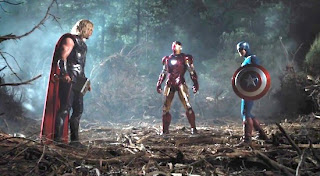The Dictator
** out of ****
Directed by: Larry Charles
Starring: Sacha Baron Cohen, Jason Mantzoukas,
Anna Faris, Ben Kingsley and John C. Reilly
Running time: 83 minutes
Sacha Baron Cohen is one of this generation’s
most powerful comedy forces, whether it is lampooning sects of American culture
through his popular sketch comedy creations Ali G, Borat and Brüno (which
spawned three feature-length films) or as sterling comic relief in films like Hugo.
In his latest feature, The Dictator, Cohen
attempts to bridge the realms of sketch comedy and narrative comedy, but with mixed
results. He seems unwilling to abandon his roots as a sketch
performer, but unfortunately, his penchant for quick laughs in episodic
situations doesn’t fulfill the needs of a feature-length story.
When we first meet Cohen’s Admiral General
Shabazz Aladeen (get it?), the feared tyrant of the fictional North African
region of Wadiya, the comic stands tall and proud on the balcony of a
gold-encrusted desert palace.
Aladeen gleefully announces to his people that
he is close to enriching weapons-grade uranium. This draws staunch condemnation
from the United Nations – or what Aladeen calls “the devil’s nest of America.”
The dictator and his staff travel to New York to face the diplomacy.
Before getting to the UN, though, an undercover
operative assigned by the dictator’s uncle, Tamir (Ben Kingsley), strips
Aladeen of his beard. Tamir wants to turn Wadiya into a thriving democracy and
unleash its oil reserves. He gets Aladeen’s oblivious double (also played by
Baron Cohen) to pretend he is the ruler and get goodwill from the UN.
Without his beard, none of the protesters
outside the UN recognizes the real Aladeen when he shows up. Instead, the crowd
thinks he is a political dissident, including Zoey (Anna Faris), an exaggerated
left-wing stereotype – she owns a vegan, organic, environmentally friendly
bakery of sorts – that also becomes Aladeen’s inevitable love interest.
The Dictator features some comic landmines from
earlier Baron Cohen films, from the sly ethnically altered music (R.E.M.’s
powerful tear-jerker “Everybody Hurts” is hilariously dubbed in Wadiyan) to
mixing in Hebrew with the foreign gibberish the protagonist uses (here, it
doubles as fake Arabic).
However, the film is an awkward mix of sketch
comedy scenes and a linear, coherent narrative. Some of the sketch comedy
scenes are riotously funny, including a helicopter scene over Manhattan that
flirts disastrously with 9/11 references.
Others feel dated, relying on broad slapstick
and tired ideas, such as one scene where Aladeen tries to make up a fake name
for himself at a restaurant by taking the phonetic sounds from signs hanging
around.
As a result, the story progression feels forced
and leaves some terrific actors at the butt of uninspired material. John C.
Reilly’s coy hotel clerk, the unconvincing (and quite misogynist) romance with
Anna Faris’s Zoey, and embarrassing cameos from Edward Norton and Garry
Shandling are only a few examples of primary actors being wasted on inferior
secondary characters.
I enjoyed many of the comedy set-ups in The
Dictator – I never thought that I would laugh at the Munich Olympics murders
and infanticide so freely – but at the end of the film, very little of the
material worked for the benefit of the story.
The film is frenetically silly and often
hilarious, but rarely convincing. The characters are such obvious stereotypes that it’s difficult to feel the cutting swipes Cohen and director Larry Charles are aiming for. It’s
a hard movie to take seriously, which could have been a compliment if The
Dictator didn’t attempt to be a topical political satire.




































